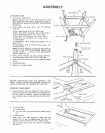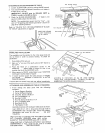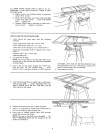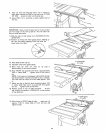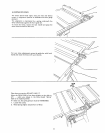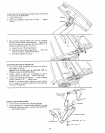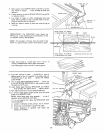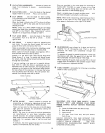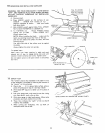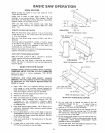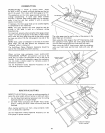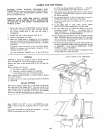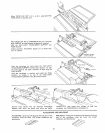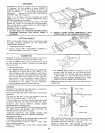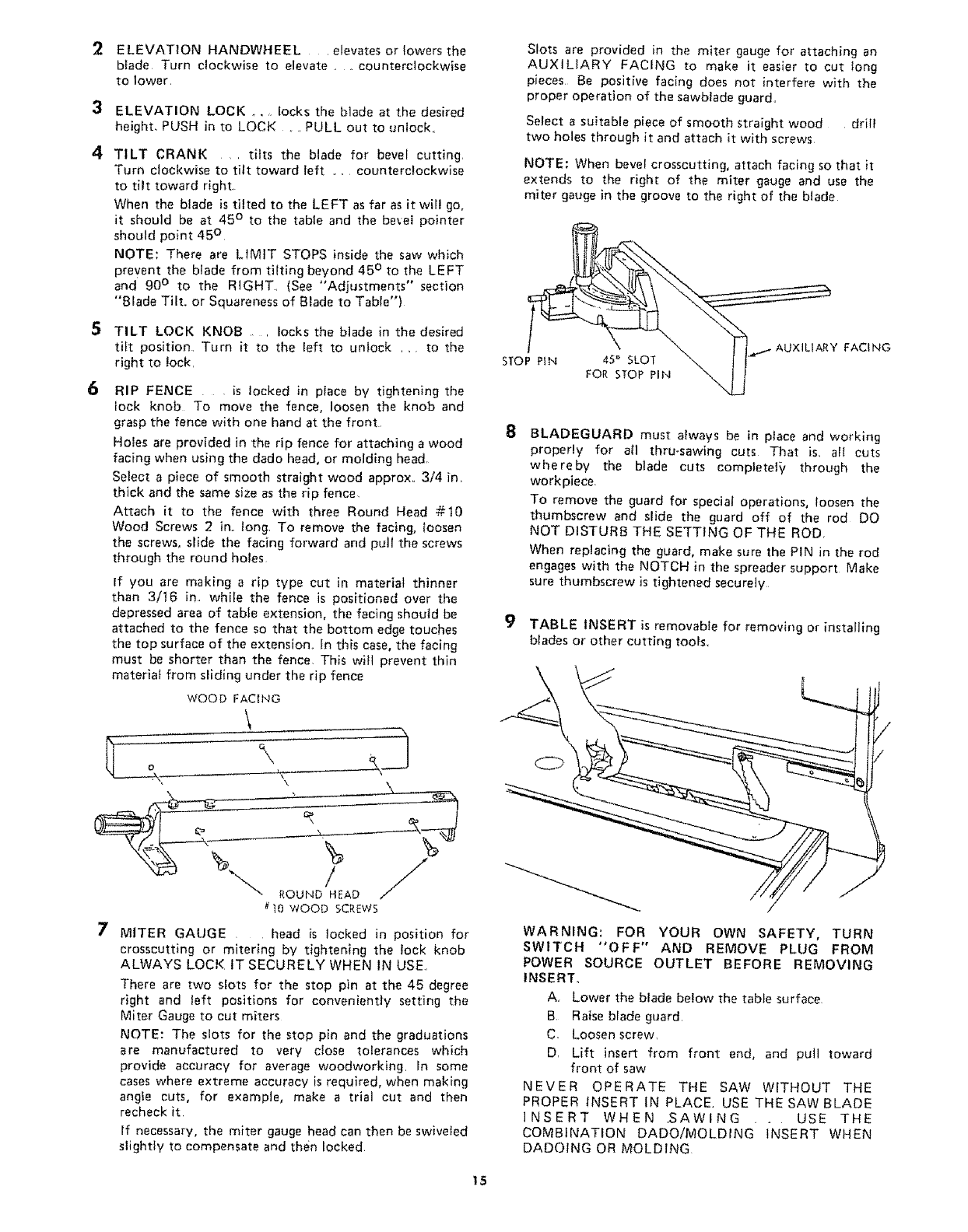
_- ELEVATION HANDWHEEL ,elevates or lowers the
blade Turn clockwise to elevate .... counterclockwise
to lower,
3 ELEVATION LOCK ..... locks the blade at the desired
height. PUSH in to LOCK .... PULL out to unlock.
4 TILT CRANK , tilts the blade for bevel cutting,
Turn clockwise to tilt toward [eft .... counterclockwise
to tilt toward right,
When the blade is tilted to the LEFT as far as it will go,
it should be at 45 ° to the table and the be_el pointer
should point 45 °
NOTE: There are LIMIT STOPS inside the saw which
prevent the blade from tilting beyond 450 to the LEFT
and 90 ° to the RIGHT., (See "Adjustments" section
"Blade Tilt. or Squareness of Blade to Table")
6
TILT LOCK KNOB , locks the blade in the desired
tilt position, Turn it to the left to unlock .... to the
right to lock,
RIP FENCE , is locked in place by tightening the
lock knob To move the fence, loosen the knob and
grasp the fence with one hand at the front
Holes are provided in the rip fence for attaching a wood
facing when using the dado head, or molding head,
Select a piece of smooth straight wood approx. 3/4 in,
thick and the same size as the rip fence,
Attach it to the fence with three Round Head #t0
Wood Screws 2 in,, long, To remove the facing, loosen
the screws, slide the facing forward and pull the screws
through the round holes
ff you are making a rip type cut in material thinner
than 3/t6 in,, while the fence is positioned over the
depressed area of table extension, the facing should be
attached to the fence so that the bottom edge touches
the top surface of the extension,, In this case, the facing
must be shorter than the fence This will prevent thin
material from sliding under the rip fence
WOOD FACING
\
10 WOOD SCaEWS
7 MITER GAUGE head is locked in position for
crosscutting or mitering by tightening the Iock knob
ALWAYS LOCK IT SECURELY WHEN IN USE,,
There are two slots for the stop pin at the 45 degree
right and left positions for conveniently setting the
Miter Gauge to cut miters
NOTE: The slots for the stop pin and the graduations
are manufactured to very close tolerances which
provide accuracy for average woodworking, In some
cases where extreme accuracy is required, when making
angle cuts, for example, make a trial cut and then
recheck it
If necessary, the miter gauge head can then be swiveled
slightly to compensate and then locked
Slots are provided in the miter gauge for attaching an
AUXILIARY FACING to make it easier to cut tong
pieces Be positive facing does not interfere with the
proper operation of the sawbtade guard,
Select a suitable piece of smooth straight wood drill
two holes through it and attach it with screws
NOTE: When bevel crosscutting, attach facing so that it
extends to the right of the miter gauge and use the
miter gauge in the groove to the right of the blade
STOP PIN 45_ SLOT
.P,N Fo %LOTp,.
BLADEGUARD must always be in place and working
properly for atl thru-sawing cuts That is. all cuts
whereby the blade cuts completelY/ through the
workpiece,
To remove the guard for special operations, loosen the
thumbscrew and slide the guard off of the rod DO
NOT DISTURB THE SETTING OF THE ROD,
When replacing the guard, make sure the PIN in the rod
engages with the NOTCH in the spreader support Make
sure thumbscrew is tightened securely
9 TABLE INSERT is removable for removing or installing
blades or other cutting tools,
WARNING: FOR YOUR OWN SAFETY, TURN
SWITCH "OFF" AND REMOVE PLUG FROM
POWER SOURCE OUTLET BEFORE REMOVING
INSERT,
A,r Lower the blade below the table surface
B Raise blade guard,
C, Loosen screw,
D, Lift insert from front end, and pull toward
front of saw
NEVER OPERATE THE SAW WITHOUT THE
PROPER tNSERT tN PLACE USE THE SAW BLADE
INSERT WHEN .SAWING .... USE THE
COMBINATION DADO/MOLDtNG INSERT WHEN
DADOING OR MOLDING
t5



